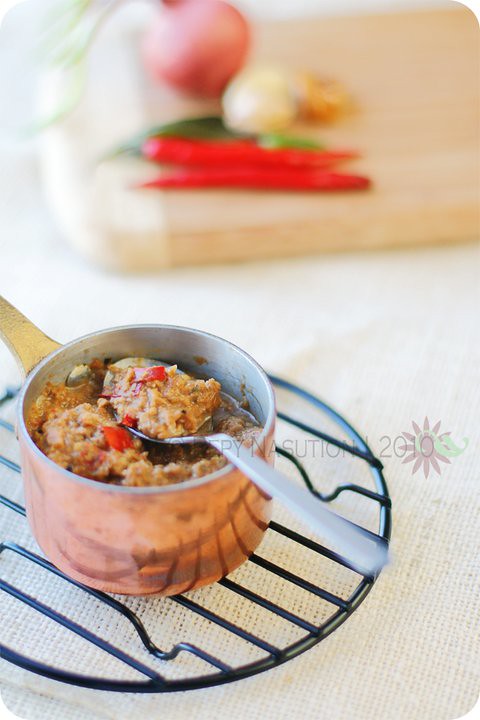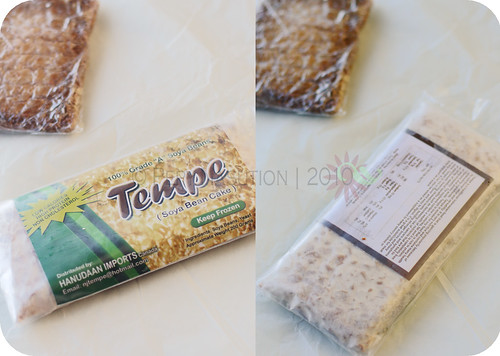
Tempe or tempeh is an Indonesian soybean cake. In order making sambal tumpang, you need tempe semangit. Semangit is derived from a word "sangit" which is meant less pleasant odour. A word "semangit" usually is followed after a word "tempe", and known as Tempe semangit. What is tempe semangit and is it different from tempe?
Tempe semangit can be categorized as an old or rotten tempe. What did I mean by old or rotten tempe? First of all, I will explain briefly the process on making tempe. You will need cooked soybeans, then add Rhizopus, a mold that helps soybeans to ferment for 24 hours. When the fermentation process is done, it binds the soybeans into a compact white cake. According my internet research, it will take more than 24 hours to ferment cooked soybeans into tempe in North America; it's about 36-48 hours.
Tempe is a protein alternative resource for vegetarians or vegans. Back when I was in Indonesia, tempe is a cheap protein resource and totally different since I moved to Canada; tempe becomes an expensive protein choice. Tempe is not only rich in essential amino acids, it is also high in vitamin B12.
When the tempe has undergone the fermentation more than a day and untreated, it will be overly ripe or rotten and known as tempe busuk or semangit because the smell is dreadful. But it doesn't make the tempe become useless. The Javanese seeks and uses it for cooking sambal or adding to a vegetable dish. Please see closely the different profile of tempe and tempe semangit.

The one on the right hand corner of each photo is tempe semangit
There are two places in Java that claimed Sambal Tumpang as their dish, Kediri (East Java) and Solo (Central Java). However, both places have a slightly different way in the recipe and serving. In Central Java, sambal tumpang is added with other protein resources such as beef, tofu as well as vegetables ("it tastes better with petai - stinky beans" said my friend Haley) while in East Java this sambal is pure made from a combination of 75% old tempe and 25% fresh/frozen good tempe. In this post, I will include the Eastern Javanese way for sambal tumpang.
In East Java, sambal tumpang is drizzled over pecel (Java style salad with peanut sauce). On the other hand, in Central Java, sambal tumpang is a side dish that is eaten with warmed cooked rice and boiled vegetables; no pecel to company.
Sambal Tumpang
- Java Style Old Tempe Sambal -
Ingredients:
200 g tempe semangit (use fresh or frozen tempe if you can't find tempe semangit)
1 cm galangal, bruised
2 Indonesian bay (salam) leaves
200 ml coconut milk
1 cup (250 mL) water
Spices to be ground:
45 g peeled shallots
5 g peeled garlics
1 cm peeled kencur/kaempeferia galangal (substitute for 1/2 tsp kencur powder)
6 kaffir lime leaves, chopped
1 tsp toasted coriander seed
1/2 tsp terasi/dried shrimp paste (optional)
1 candlenut (substitute for macadamia nut)
3 red cayenne peppers (Indonesian: cabe merah keriting)
1 bird eye chili
seasalt
Methods:
1. Pound or chop tempe semangit with a pestle or a chopper.
2. In a pot, add pounded tempe, ground spices, salam leaves, galangal and water. Cook until a boil. Then turn the heat to low and simmer for 5 -10 more minutes or until the spices absorb.
3. Add coconut milk, stir occasionally and bring to re-boil. Remove from the heat. Serve with pecel and warm cooked rice.
0 comments:
Post a Comment